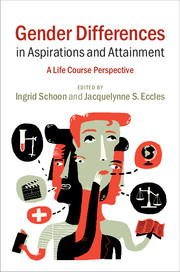Book contents
- Frontmatter
- Contents
- List of Figures
- List of Tables
- Notes on Contributors
- List of Abbreviations (selected)
- Part I Introduction
- Part II The early school years
- Part III Career planning during adolescence
- Part IV Choosing a science career
- 9 Do teenagers want to become scientists?
- 10 Predicting career aspirations and university majors from academic ability and self-concept
- 11 Does priority matter?
- 12 Gender differences in personal aptitudes and motivational beliefs for achievement in and commitment to math and science fields
- 13 What happens to high-achieving females after high school?
- 14 Young people, gender, and science
- 15 Motivational affordances in school versus work contexts advantage different individuals
- Part V Longer-term consequences of early experiences
- Part VI The role of context
- Index
- References
9 - Do teenagers want to become scientists?
A comparison of gender differences in attitudes toward science, career expectations, and academic skill across 29 countries
Published online by Cambridge University Press: 05 October 2014
- Frontmatter
- Contents
- List of Figures
- List of Tables
- Notes on Contributors
- List of Abbreviations (selected)
- Part I Introduction
- Part II The early school years
- Part III Career planning during adolescence
- Part IV Choosing a science career
- 9 Do teenagers want to become scientists?
- 10 Predicting career aspirations and university majors from academic ability and self-concept
- 11 Does priority matter?
- 12 Gender differences in personal aptitudes and motivational beliefs for achievement in and commitment to math and science fields
- 13 What happens to high-achieving females after high school?
- 14 Young people, gender, and science
- 15 Motivational affordances in school versus work contexts advantage different individuals
- Part V Longer-term consequences of early experiences
- Part VI The role of context
- Index
- References
Summary
Abstract
In this chapter we investigate how boys’ and girls’ ability and attitudes toward science differ as they approach the end of compulsory schooling. We begin by comparing their performance on an internationally standardized test, before investigating the proportion of boys and girls aspiring to a scientific career. Results are compared across a set of 29 developed countries. Gender differences in science achievement tests completed at age 15 are small, yet boys and girls wish to enter very different careers. In all 29 countries boys are more likely than girls to expect entry into careers involving physical science or mathematics, while girls prefer a career in life sciences and the health professions.
Introduction
Over the past 15 to 20 years, educational attainment has risen dramatically across all developed countries. Whereas in 1995 only one in five children living in OECD countries completed university, this figure has almost doubled to one in three today (OECD, 2008, table A3.2). One particularly noticeable feature in almost every country in the developed world is the rising trend of women now outnumbering men in accessing tertiary education (OECD, 2008). However, men and women are not evenly distributed among the different disciplines. Compared to boys, girls are less likely to study a subject relating to the natural sciences (especially physics), technology, engineering, or math (STEM) (OECD, 2008, table A3.5). This is despite the STEM disciplines offering the greatest economic rewards. For example, Black, Sanders, and Taylor (2003) show that in the United States social science, art, education, and humanities graduates earn roughly 30% less than economists, mathematicians, scientists, and engineers. A similar picture is evident in Europe, where STEM graduates tend to have higher earnings than non-STEM graduates (DIUS, 2009).
- Type
- Chapter
- Information
- Gender Differences in Aspirations and AttainmentA Life Course Perspective, pp. 203 - 223Publisher: Cambridge University PressPrint publication year: 2014
References
- 13
- Cited by

